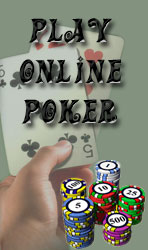Pokerwiner.com → Lessons of poker
BLUFFING ACCORDING TO YOUR OPPONENT
You must, of course, consider your opponent when deciding whether to bet a fair hand for value or to bluff. Against a perpetual caller, obviously you should rarely bluff.
However, against such a player you should bet any hand that you figure is a reasonable favorite to be the best poker hand.
In contrast, against a tough player capable of tough folds, you can get away with bluffs more often, but you should be more reluctant to bet your fair hands for value.
A tough opponent is not likely to pay you off with his worse hands, and when he does call, he’s likely to show down a hand that beats you.
Here is a typical situation showing when a bluff is right and when it is not. Let’s say in draw poker you draw three cards to a pair of jacks, and your opponent draws three to what you suspect is a pair of aces.
First, we’ll assume your opponent is the type of player who will almost always fold if his hand doesn’t improve. In this instance, your play is to bluff if you don’t improve since you may make your opponent throw away his pair of aces.
However, if you make jacks up, you should check rather than bet for value since you are a big underdog if you bet and get called. If your opponent calls, he is likely to have made aces up.
Now let’s assume your opponent is the type who almost never folds. Against this online poker player you cannot bluff with one pair because he will almost certainly call you with his bigger pair.
However, if you make jacks up against him, then you should bet for value since your two pair are almost a 5-to-2 favorite to be the best hand when you get called.
The difference is that this opponent will call with one pair of aces as well as with aces up, whereas the first opponent would most likely not have called with only a pair of aces.
BLUFFING AS ADVERTISING
When you get caught bluffing, you of course lose. However, you may not mind being caught and losing early in a session because you are considering your image for future hands.
You may even make an ill advised bluff early so that you will get a lot more call on your legitimate hands the rest of the night. (Similarly, an early ill-advised call against tough players may keep them from bluffing against you the rest of the night because they fear you’re likely to call their bluffs.)
Creating an image that you almost never bluff can also be advantageous. I am generally considered a tight player, and I sometimes pass up an early, marginally profitable bluffing situation to enhance this image.
What that does is allow me to steal some pots in the future with complete impunity. No one imagines I am daring to bluff.
When you are up against even average players, they are constantly studying the way you play. So considering the effect of any play on future hands should be an important part of your game, especially in no-limit and pot-limit poker and especially when you are playing against the same people all night or from one night to the next or one week to the next.
Some players go so far as to argue that bluffs should show a loss because those losses will be repaid with interest when they get a lot of action on their legitimate hands.
Game theory, as we shall see in the next chapter, suggests that when you employ optimal bluffing strategy, you should break even on your bluffs.
However, there is no reason not to develop a sense of your opponents and of betting situations so your bluffs show a profit.
A successful bluff wins the whole pot, and it takes a lot of extra calls of your legitimate hands to make up for one pot. Therefore, against all but very tight players, you should slightly less than optimally so your bluffs show a profit.
The greater your reputation as a tight player, the more you will be able to get away with bluffs. At the same time, you will still get caught often enough to get paid off when you do have a good hand.
Summary
A bluff is a bet or raise with a hand you do not think is the best hand. With more cards to come, you should generally restrict yourself to semi-bluff with hands that may become the best hand.
When deciding whether to make a pure bluff, you estimate whether your chances of getting away with it are better than the pot odds you are getting.
However, if there are more cards to come and you plan to continue to bluff, you must take into account your effective odds.
On the end you should usually bluff with a busted hand when you think your opponent is weak. Against a tough player, the bluff tends to work more often in first position.
However, if you have a hand with some value, don’t bet when you are first so that you can snap off your opponent’s bluffs.
If you are in second position and your opponent checks, show down these same hands since they have little chance of winning if you bet and get called.
The odds against a bluff’s working increase almost geometrically with each extra person in a pot odds. Therefore, it is rarely correct to try to bluff out two or more players, especially on the end.
When to bluff and when to bet a fair hand for value is a difficult problem of judgment and experience. In general, if you do not think you could get away with a bluff, you should bet your fair hands for value; if a fair hand cannot be a profitable bet, then a bluff should be.
Bluffs are another tool of the well-rounded poker player. In my opinion, they should show a long-run profit the same as any other poker play. Even if you get caught only occasionally, you can still expect to get paid off when you do have a hand.



